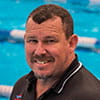How to Buy and Use Paddles
Get the most out of these key pieces of training equipment
Typically, swimmers use equipment for one of two reasons: to strengthen something or assist them while they work on something else.
When you’re strengthening, your equipment adds extra resistance so the muscles that support that movement get stronger. Using paddles is a good example of this.
When you need an assist, equipment that makes a propulsive movement more efficient or easier allows you to isolate and concentrate on improving some other area. Using fins to keep your legs near the surface and provide speed and stability while you work on your pull is a good example of this.
Paddles have a third use: to enhance the feedback on your movements in the water so that you can make technique adjustments.
If you’ve considered getting paddles, you’ve undoubtedly discovered that there are a variety of different sizes, and styles.
Size Matters
One of the most important things to consider is size. Sizes range from minimalist (very small) to what have been referred to as “trashcan lids” (very large). Here are a few questions to ask yourself as you try to decide what size paddles to purchase.
- Do you have a coach? Many swimmers are self-coached or swim with a group without an on-deck coach, but if you have a knowledgeable coach, ask your coach why a particular size might be best for you. Recommendations from other swimmers are also helpful, but because paddles increase strain on your shoulders, it’s important to consider your stroke and not just do what the fastest swimmer does.
- What is your experience level? Seasoned swimmers have already gone through the process of trial and error. They’ve likely been through multiple sizes and shapes and have developed muscles to support larger paddles. If you’re coming to the sport later, then your best bet is to start small. Increased pressure on the water puts additional strain on your shoulders. Starting small allows you to feel if there are any movements in your stroke that are causing discomfort and adjust your technique to eliminate that.
What About Shape and Style?
Shape is all over the place as product designers and swimmers have become creative in what they want paddles to do. There are some that mimic the natural shape of the hand and others that extend down past the wrist and others that cover only the fingertips or are specific to a particular stroke. Many swimmers have several different styles in their equipment bag.
Fingertip paddles work very well as a starter because they don’t put extra strain on your joints, can be used for every stroke, and will give you valuable feedback on how you initiate your catch. Other shapes, such as FINIS’s Freestyler, are designed specifically for freestyle. Many paddles have straps, some have none.
If you swim with a group, it’s likely that your fellow swimmers have a variety of different styles and sizes. Ask to try their equipment. You’ll get a chance to see how the various types feel before you buy a set.
Getting the Most Out of Your Paddles
If you start using paddles and feel pain, stop—clearly there’s something wrong. It could be the size and shape of the paddle or your technique or a combination. Seek out a knowledgeable coach to help you.
Strap configurations are different across paddle types, but many feature a wrist strap and straps for the fingers. It’s important to not tighten these too much, especially if they seem to be sliding around or pulling away from your hand. This means that the water pressure is not holding the paddles on your hands and the straps are doing all the work. Make some adjustments to get the pressure to hold the paddle on your hand.
When you don’t feel the paddles moving on your hands as much, be bold and remove the wrist straps. Removing the wrist straps allows you to fine-tune your catch and pull—if the paddle slips around, you aren’t catching and pulling correctly. This is valuable feedback that can lead you to significant technique improvements.
Categories:
- Products and Reviews














